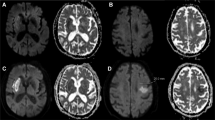Abstract
We studied the relationship between infarct size and degree of internal carotid artery stenosis in 227 stroke patients without a source of embolism in the heart, who had a CT-verified territorial brain infarct. We used logistic regression analysis adjusting for differences between groups in co-associated variables such as age, sex, hypertension, diabetes mellitus, and a history of ischaemic heart disease. Ipsilateral carotid stenosis greater than 50% was more strongly associated with large than small infarcts; adjusted odds ratio [(a)OR]: 4.56; 95% confidence interval (CI): 1.21-17.2;P = 0.02. For ipsilateral carotid occlusion the association was even stronger - (a)OR: 36.80; 95% CI: 2.54-533;P = 0.007. When large infarcts were compared with infarcts of small and moderate size together the ORs were 2.29, 95% CI 1.14–4.58 and 2.57, 95% CI 1.17–5.67 for carotid stenosis or occlusion, respectively. Our data show a relationship between greater than 50% carotid stenosis or occlusion and large brain infarcts. We suggest that haemodynamic impairment may contribute to infarct size in territorial infarcts of non-cardiac origin.
Similar content being viewed by others
References
Babikian VL, Hyde C, Pochay V, Winter MR (1994) Clinical correlates of high-intensity transient signals detected on transcranial Doppler sonography in patients with cerebrovascular disease. Stroke 25:1570–1573
Bogousslavsky J, Regli F (1985) Cerebro-retinal ischemia after bilateral occlusion of internal carotid artery. A study with prospective follow-up. Neuroradiology 27:238–247
Caplan LR (1986) Carotid artery disease. N Engl J Med 315:886–888
Caplan LR (1993) Large-vessel occlusive disease of the anterior circulation. In: Caplan LR (ed) Stroke. A clinical approach. Butterworth-Heinemann, Boston, pp 195–236
Droste DW, Markus HS, Nassiri D, Brown MM (1994) The effect of velocity on the appearance of embolic signals studied in transcranial Doppler models. Stroke 25:986–991
Eliasziw M, Streifler JY, Fox AJ, Hachinski VC, Ferguson GG, Barnett HJM for the North American Symptomatic Carotid Endarterectomy Trial (1994) Significance of plaque ulceration in symptomatic patients with highgrade carotid stenosis. Stroke 25:304–308
Fürst H, Hard WH, Janssen I (1994) Patterns of cerebrovascular reactivity in patients with unilateral asymptomatic carotid artery stenosis. Stroke 25:1193–1200
Goldenberg G, Reisner T (1983) Angiographic findings in relation to clinical course and results of computed tomography in cerebrovascular disease. Eur Neurol 22:124–130
Grosset DG, Georgiadis D, Kelman AW, Lees KR (1993) Quantification of ultrasound emboli signals in patients with cardiac and carotid disease. Stroke 24:1922–1924
Grosset DG, Georgiadis D, Abdullah I, Bone I, Lees KR (1994) Doppler emboli signals vary according to stroke subtype. Stroke 25:382–384
Hankey GJ, Warlow CP (1991) Prognosis of symptomatic carotid artery occlusion. An overview. Cerebrovasc Dis 1:245–256
Hard WH, Janssen I, Fürst H (1994) Effect of carotid endarterectomy on patterns of cerebrovascular reactivity in patients with unilateral carotid artery stenosis. Stroke 25:1952–1957
Kleiser B, Widder B (1992) Course of carotid artery occlusion with impaired cerebrovascular reactivity. Stroke 23:171–174
Lodder J, Bamford J, Kappelle J, Boiten J (1994) What causes false clinical prediction of small deep infarcts? Stroke 25:86–91
Pessin MS, Hinton RC, Davis KR (1979) Mechanisms of acute carotid stroke. Ann Neurol 6:245–252
Powers WJ (1991) Cerebral hemodynamics in ischemic cerebrovascular disease. Ann Neurol 29:231–240
Ringelstein EB, Sievens C, Ecken S, Schneider PA, Otis SM (1988) Noninvasive assessment Of CO2-induced cerebral vasomotor response in normal individuals and patients with internal carotid artery occlusions. Stroke 19:963–969
Ringelstein EB, Weiller C, Weckesser M, Weckesser S (1994) Cerebral vasomotor reactivity is significantly reduced in low-flow as compared to thromboembolic infarctions: the key role of the circle of Willis. J Neurol Sci 121:103–109
Schneider PA, Rossman ME, Bernstein EF, Torem S, Ringelstein EB, Otis SM (1988) Effect of internal carotid artery occlusion in transcranial hemodynamics. Transcranial Doppler evaluation and clinical correlation. Stroke 19: 589–593
Smith HA, Thompson-Dobkin J, Yonas H, Flint E (1994) Correlation of Xenon-enhanced computed tomography-defined cerebral blood flow reactivity and collateral flow patterns. Stroke 25:1784–1787
Steinke W, Meairs S, Hennerici M (1994) Pathophysiologic assessment of data from a stroke data bank. Neuroepidemiology 13:324–334
Timsit SG, Sacco RL, Mohr JP, Foulkes MA, Tatemichi TK, Wolf PA, Price TR, Hier DB (1993) Brain infarction severity differs according to cardiac or arterial embolic source. Neurology 453:728–733
Van der Grond J, Balm R, Kappelle LJ, Eikelboom BC, Mali WPTM (1995) Cerebral metabolism of patients with stenosis or occlusion of the internal carotid artery. A1H-MR spectroscopic imaging study. Stroke 26:822–828
Weiller C, Ringelstein EB, Reiche W, Buell U (1991) Clinical and hemodynamic aspects of low-flow infarcts. Stroke 22:1117–1123
Widder B, Kleiser B, Krapf H (1994) Course of cerebrovascular reactivity in patients with carotid artery occlusions. Stroke 25:1963–1967
Yamauchi H, Fukuyama H, Kimura J, Konishi J, Kameyama M (1990) Hemodynamics in internal carotid artery occlusion examined by positron emission tomography. Stroke 21:1400–1406
Author information
Authors and Affiliations
Rights and permissions
About this article
Cite this article
Lodder, J., Hupperts, R., Boreas, A. et al. The size of territorial brain infarction on CT relates to the degree of internal carotid artery obstruction. J Neurol 243, 345–349 (1996). https://doi.org/10.1007/BF00868409
Received:
Revised:
Accepted:
Issue Date:
DOI: https://doi.org/10.1007/BF00868409




